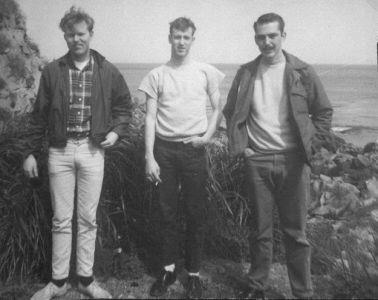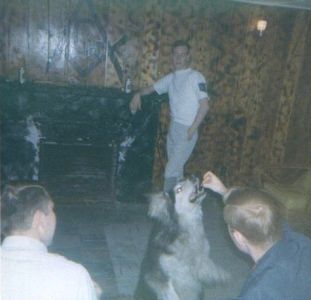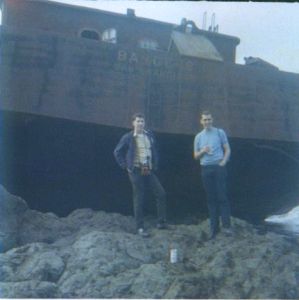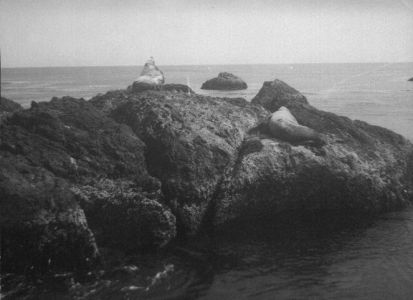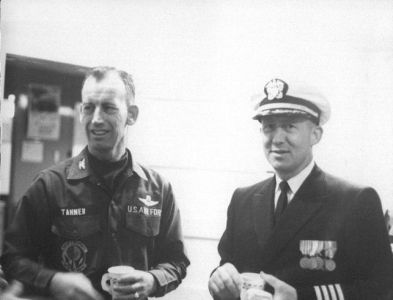|
27 Jan 2004
Hi Joe
I don't know exactly what you need for the site, but will attempt
to give you as much as I know. Adak probably had the info in
their "history" file - I'm sure they kept one, as it was a requirement
at all stations. I'm also including some pictures and other "stuff".
I believe the Shemya Detachment first started in 1965 on a temporary
basis. CT1 Bob Kenyon then went out and took the detachment over that
year and stayed a year, being relieved by me in July 1966. Bob was a
complete NUT. He was VERY knowledgable and proficient, but he had a
sense of humor that was amazing, and forever laughed at life. He was
literally loved by the Army and Air Force people on Shemya, so I
was automatically accepted by everyone on the island.
When I arrived on Adak for indoctrination for the assignment on Shemya
Bob was also there to be initiated as chief - so I participated in his
initiation. We partied all night, but were awakened early the next
morning by the Captain's yeoman who advised us that the Skipper,
Capt Phillips, wanted to see us both ASAP. We got dressed and hurried
down to his office. It was nothing important - just a bull session,
probably to get to know ME. After a few minutes we were dismissed.
On the way to the door Bob told the Skipper that he was invited to his
Change of Command ceremony the next day on Shemya. Capt Phillips didn't
miss a beat. He said, "I accept your invitation, Chief Kenyon, and I
will expect the appropriate ceremonies to be performed". He also adivised
us that he would be in full dress uniform, with medals and sword, and
would expect us and the Shemya troops to be appropriately dressed. Bob
said,"marvelous" (his favorite saying) and we left. Bob proceeded to the
CPO quarters and was going to go back to sleep. I asked him if he had
ever even SEEN a change of command ceremony - he had not. So - I went
to the personnel office and borrowed their Landing Party Manual to get
the proper ceremonial procedures. Since enlisted personel don't have
"commands" we would have to improvise the ceremony. We looked through
the manual and decided just what we would do. Meanwhile, Capt Phillips
called the CO of NavSta and asked him if he would like to go to Shemya
and spend the next night. The CO agreed and called up a P3 crew and
advised them that they would be going to Shemya,also, on a special flight
and would spend the night out there. (They were probably not too happy
about that). In any case, the next morning we got in our blues (no medals)
and, with Capt Phillips, drove to NavSta and boarded the P3 along with
the CO NavSta and the P3 crew. We had already called the Navy Det on
Shemya and told them about the situation, and that they should invite all
the senior NCO's and officers from the Army and Air Force to be at the
Shemya flight line at 10:00 AM for a change of command ceremony. The
assistant POIC of the detachment (Jack Erbes, CT3) got a couple of Air
Force guys to man our circuits, so that when we arrived on Shemya, all
9 of the Navy guys were there, lined up for inspection in one line, in
"starched and pressed dungarees, with white hats and foul-weather jackets".
We got off the plane and there were probably fifty NCO's and officers
standing by for the ceremony. Capt Phillips and the CO NavSta inspected
the troops, after which Capt Phillips made a short speech. Then Bob made
a few remarks about how he had enjoyed working with the men. Then I
stepped forward and made a few comments, turned to Chief Kenyon, saluted
him, and said, "Chief Kenyon, I now relieve you as Commander Naval Forces
Shemya", to which he replied, "I stand relieved". It was GREAT!!!; and
made quite an impression on all the Army and Air Force people, I'm sure,
as I don't think they would have done a "Change of Command" ceremony for
enlisted people. But Capt Phillips LOVED it and made a big deal of it.
He later sent me a desk plate for the work spaces - CTCS P. A. POOLE
COMNAVFOR SHEMYA. It is one of my prize possessions, even though I have
other (more ornate) deskplates. In fact, when I left Shemya he came out
again, with the CO NavSta, the P3 crew, and my relief in tow. This time,
however, we had to hold the ceremony in the gymnasium because of inclement weather.
I can't remember the name of the chief who relieved me, but I have his
picture and am including it in the packet. Don't think he had the same
sense of humor that Kenyon and I had, but he stayed for the July 67-
July 68 tour. I don't know how long the detachment remained out there
nor much that happened after I left. When I left I had a CT2 as my
assistant - the only man over 3rd class (other than the CPOIC) that had
ever been with the detachment. I heard through the grapevine that he
and the new CPOIC did not relate very well and, on occasion got into
each other's face over a few things, especially military matters, but I
don't know that for a fact. I had been pretty lenient with the men, with
no inspections at all, etc. He may have changed things a little.
The tour was a great experience, but the loneliest and toughest time of
my life. The morale out there was outstanding, as there were no women
within thousands of miles and everyone was in the same situation, so to
speak. I would meet the Island Commander (Col. Tanner) in the hallway
of the Composite Building, and ask him how many days he had left - and
he would reply "(so many) days and a wakeup". You couldn't complain to
anyone about missing your wife and kids - as you knew they missed their
wives and kids also. I only saw one fist swung the whole year, and that
was by one civilian who took a swing at his best friend while drinking
at the NCO Club bar. They immediately made up and it was forgotten.
Meanwhile, on Adak, the bar got torn up every night by fighting.
The detachment had one CPOIC, one assistant (the senior white hat, mostly
a CT3) and 8 radio operators, all R branchers, mostly CTSN's with one or
two CT3's. These men were on their first assignment out of CT School,
and had been trained on Adak for the job on Shemya. They would come to
me for the last 6 months of their Adak assignment and were stuck on the
"Rock" for the duration. I was the only man on the island who could not
go on leave, including Army and Air Force personnel, since I had no
relief for my job. My men couldn't leave after arriving either, but they
only had a few months to do, and had been offered leave while still at
Adak. We had two intercept positions and ran a 4-section watch.
We sent out two reports a day to Adak and NSA. I sent out the day report
and (naturally) my assistant sent out the night report. If I had partied
too much the night before and decided to sleep in, one of the operators
would send in the report or call either me or the assistant POIC in. So
the duty was a snap. The ONLY problem was the loneliness, and anything
was acceptable if it would just pass the time. I don't drink now, but
that year was a year-long party. I read western novels, and I must have
averaged one a day! I used to get them sent to me by the 1' X 2' boxfuls.
The Air Force furnished us with a vehicle, the worst on the rock, but at
least it was mine. My first one was an old METRO, a bread-truck looking
thing. The "M" was missing from the front, so it was known as the "ETRO".
The only people who ever drove it was the assistant and me. It had sliding
doors on each side, and Boozer, the island mascot, went with me everywhere
I went, cause I would leave the right door open and he would sit in the
wheel well with his head looking out and his hair blowing in the breeze.
Boozer is another story, well loved by everyone.
The Composite Building was where we all lived, ate, etc. It had a PX
(maybe 10 feet square), chow hall, Army and Air Force offices, etc. The
officers' quarters were also in it, as was the senior NCO quarters, where
I slept. It was the headquarters for the island. In front of it was
a "plug", made of concrete connected to a chain, so that anyone strong
enough could "pull the plug" and let the island sink into the Bering Sea.
Also near the plug was a fire hydrant for Boozer's purpose only. We also
had other buildings - a motor pool, chapel, supply, gymnasium, movie
theater, and hobby shop within walking distance. About a half mile away
was the NCO club (later a new one was built near the Composite Building).
In another direction from the Composite Building were a couple of Operations
building (where we worked) and the huge radar structures. Shemya was the
westernmost link in the DEW line - and that radar interference fed into
all the radio and TV equipment on the island, even though we had cable TV
(after a fashion). As I remember we had one channel, channel 3, which ran
Crusader Rabbit and Felix the Cat cartoons, HUNDREDS OF THEM, over and over.
The Air Force was the host, having the most troops, probably around 600-700.
The Army had about 400-600 people (I'm guessing on this) and had their own
dorms within the Composite Building. My troops had four rooms in one of the
Army dorms and I had a room in the Senior NCO dorm, labelled the "Senior
Citizens' Ward", and which was isolated from the other sleeping quarters.
My best friends were the ARMY ASA NCO's. In fact, I sat in on their
promotion boards when their troops came up for promotion. I could comment
about the applicants' capabilities, including military appearance, etc., but
I didn't have a vote. The Army had a LCOL in charge, with a Capt as the XO.
The 1st Sgt was an E-8 and a good friend of mine. The Air Force had a COL
as the island commander. The Air Force Security Service had a Major in
charge, who was one of my drinking buddies (as was the chaplain).
There were a number of old WWII buildings still standing, all wooden, of
course, and which had fireplaces. These were taken over by the different
units and made into party huts for each unit. I was an honorary member of
each of the units and could use the huts any time I wanted. They were
called "smokehouses" because the wind blew smoke into your eyes all the
time. The island had a 35 knot wind most of the time.
I could go on and on - and I HAVE over the years, as I have so many memories
of the place. But I'll stop for now. Let me know if there is anything else
I could furnish you for your website. Think I have a couple copies of the
"RAG", an unofficial fun-type newspaper put out by the Army (mostly by the
Top Sergeant) once a week. They would mention the Navy guys every so often,
mainly because I was probably in Top's room when he typed it up. I would
furnish him Navy quotations, like "Damn the torpedoes, let's get the hell
out of here". The RAG would probably be too much for your website.
'Nuff for now.
Pappy
|










